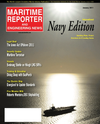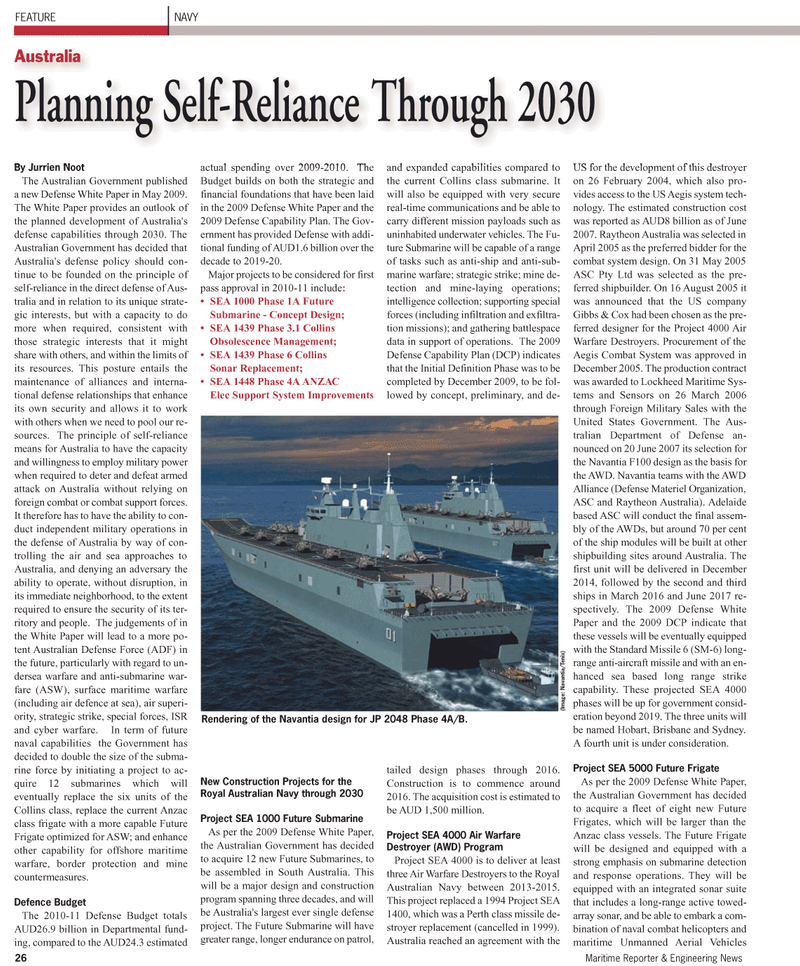
Page 26: of Maritime Reporter Magazine (January 2011)
International Naval Technology
Read this page in Pdf, Flash or Html5 edition of January 2011 Maritime Reporter Magazine
FEATURE NAVY 26 Maritime Reporter & Engineering News
By Jurrien Noot
The Australian Government published a new Defense White Paper in May 2009.
The White Paper provides an outlook of the planned development of Australia's defense capabilities through 2030. The
Australian Government has decided that
Australia's defense policy should con- tinue to be founded on the principle of self-reliance in the direct defense of Aus- tralia and in relation to its unique strate- gic interests, but with a capacity to do more when required, consistent with those strategic interests that it might share with others, and within the limits of its resources. This posture entails the maintenance of alliances and interna- tional defense relationships that enhance its own security and allows it to work with others when we need to pool our re- sources. The principle of self-reliance means for Australia to have the capacity and willingness to employ military power when required to deter and defeat armed attack on Australia without relying on foreign combat or combat support forces.
It therefore has to have the ability to con- duct independent military operations in the defense of Australia by way of con- trolling the air and sea approaches to
Australia, and denying an adversary the ability to operate, without disruption, in its immediate neighborhood, to the extent required to ensure the security of its ter- ritory and people. The judgements of in the White Paper will lead to a more po- tent Australian Defense Force (ADF) in the future, particularly with regard to un- dersea warfare and anti-submarine war- fare (ASW), surface maritime warfare (including air defence at sea), air superi- ority, strategic strike, special forces, ISR and cyber warfare. In term of future naval capabilities the Government has decided to double the size of the subma- rine force by initiating a project to ac- quire 12 submarines which will eventually replace the six units of the
Collins class, replace the current Anzac class frigate with a more capable Future
Frigate optimized for ASW; and enhance other capability for offshore maritime warfare, border protection and mine countermeasures.
Defence Budget
The 2010-11 Defense Budget totals
AUD26.9 billion in Departmental fund- ing, compared to the AUD24.3 estimated actual spending over 2009-2010. The
Budget builds on both the strategic and financial foundations that have been laid in the 2009 Defense White Paper and the 2009 Defense Capability Plan. The Gov- ernment has provided Defense with addi- tional funding of AUD1.6 billion over the decade to 2019-20.
Major projects to be considered for first pass approval in 2010-11 include: • SEA 1000 Phase 1A Future
Submarine - Concept Design; • SEA 1439 Phase 3.1 Collins
Obsolescence Management; • SEA 1439 Phase 6 Collins
Sonar Replacement; • SEA 1448 Phase 4A ANZAC
Elec Support System Improvements
New Construction Projects for the
Royal Australian Navy through 2030
Project SEA 1000 Future Submarine
As per the 2009 Defense White Paper, the Australian Government has decided to acquire 12 new Future Submarines, to be assembled in South Australia. This will be a major design and construction program spanning three decades, and will be Australia's largest ever single defense project. The Future Submarine will have greater range, longer endurance on patrol, and expanded capabilities compared to the current Collins class submarine. It will also be equipped with very secure real-time communications and be able to carry different mission payloads such as uninhabited underwater vehicles. The Fu- ture Submarine will be capable of a range of tasks such as anti-ship and anti-sub- marine warfare; strategic strike; mine de- tection and mine-laying operations; intelligence collection; supporting special forces (including infiltration and exfiltra- tion missions); and gathering battlespace data in support of operations. The 2009
Defense Capability Plan (DCP) indicates that the Initial Definition Phase was to be completed by December 2009, to be fol- lowed by concept, preliminary, and de- tailed design phases through 2016.
Construction is to commence around 2016. The acquisition cost is estimated to be AUD 1,500 million.
Project SEA 4000 Air Warfare
Destroyer (AWD) Program
Project SEA 4000 is to deliver at least three Air Warfare Destroyers to the Royal
Australian Navy between 2013-2015.
This project replaced a 1994 Project SEA 1400, which was a Perth class missile de- stroyer replacement (cancelled in 1999).
Australia reached an agreement with the
US for the development of this destroyer on 26 February 2004, which also pro- vides access to the US Aegis system tech- nology. The estimated construction cost was reported as AUD8 billion as of June 2007. Raytheon Australia was selected in
April 2005 as the preferred bidder for the combat system design. On 31 May 2005
ASC Pty Ltd was selected as the pre- ferred shipbuilder. On 16 August 2005 it was announced that the US company
Gibbs & Cox had been chosen as the pre- ferred designer for the Project 4000 Air
Warfare Destroyers. Procurement of the
Aegis Combat System was approved in
December 2005. The production contract was awarded to Lockheed Maritime Sys- tems and Sensors on 26 March 2006 through Foreign Military Sales with the
United States Government. The Aus- tralian Department of Defense an- nounced on 20 June 2007 its selection for the Navantia F100 design as the basis for the AWD. Navantia teams with the AWD
Alliance (Defense Materiel Organization,
ASC and Raytheon Australia). Adelaide based ASC will conduct the final assem- bly of the AWDs, but around 70 per cent of the ship modules will be built at other shipbuilding sites around Australia. The first unit will be delivered in December 2014, followed by the second and third ships in March 2016 and June 2017 re- spectively. The 2009 Defense White
Paper and the 2009 DCP indicate that these vessels will be eventually equipped with the Standard Missile 6 (SM-6) long- range anti-aircraft missile and with an en- hanced sea based long range strike capability. These projected SEA 4000 phases will be up for government consid- eration beyond 2019. The three units will be named Hobart, Brisbane and Sydney.
A fourth unit is under consideration.
Project SEA 5000 Future Frigate
As per the 2009 Defense White Paper, the Australian Government has decided to acquire a fleet of eight new Future
Frigates, which will be larger than the
Anzac class vessels. The Future Frigate will be designed and equipped with a strong emphasis on submarine detection and response operations. They will be equipped with an integrated sonar suite that includes a long-range active towed- array sonar, and be able to embark a com- bination of naval combat helicopters and maritime Unmanned Aerial Vehicles
Australia
Planning Self-Reliance Through 2030
Rendering of the Navantia design for JP 2048 Phase 4A/B. (Image: Navantia/T enix)

 25
25

 27
27
